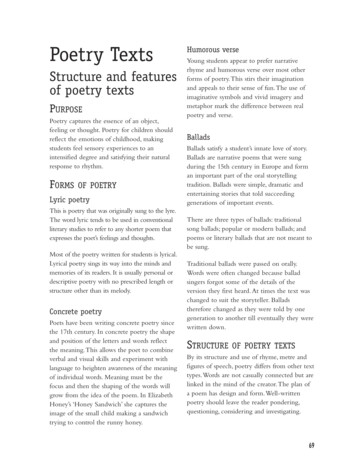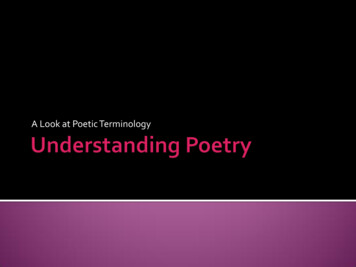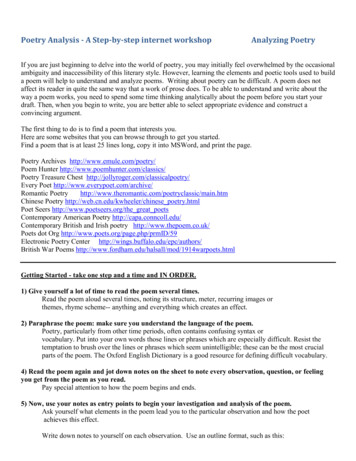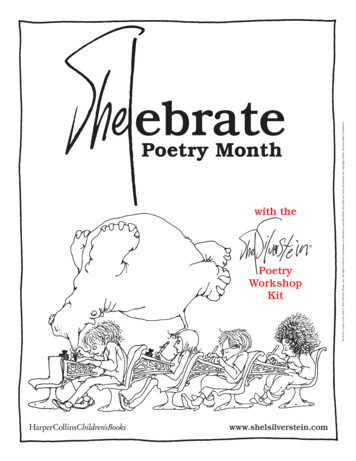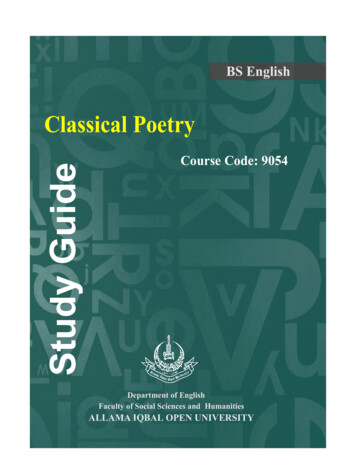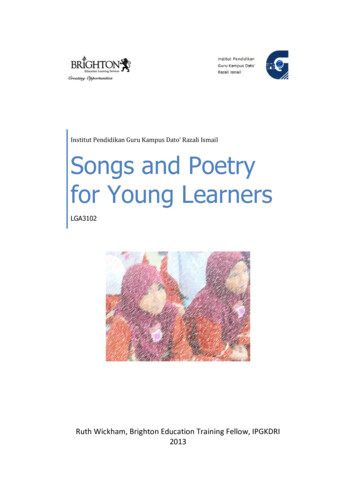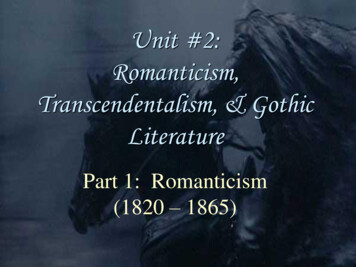
Transcription
Mr. Sylvain’s ELA ClassPoetry Unit, Winter 2014Name:Grade 9 – Poetry Unit“If you know what you are going to write when you’re writing a poem, it’s going to beaverage.”– Derek WalcottPoetry is an important genre in student writing. It gives opportunities to play withlanguage in novel ways, and sometimes to incorporate art and graphic design skills as well.Understand that it is the message that is important in poetry, not just the format or rhyming.Playing with line breaks and white space, exploring repetition and font choices for emphasis,and focusing on descriptive language that carries meaning are all ways to enhance (poetic)writing skills.During the next few weeks, you will be reading, writing, writing about, memorizing,studying, discussing, and collecting poems. Your unit grade will be primarily based on thefollowing: the work done in and around this poetry booklet your memorization of one poemyour poetry analysis essay your grade on the poetry testNote that the poetry unit is no different than any other unit, in that class participation playsan important role in your marks, as does your general behavior.It is essential that you keep this handout neat, organized. I will not make additional copiesto replace lost handouts. If you misplace a handout, you will need to copy it over by hand.Furthermore, you are responsible for making a cover for this booklet.In order to understand poetry, you will need to experience the process of writing poetry.The poems you write will be included in this poetry booklet. Although I do not expect you tobecome a world-wide acclaimed poet, I do expect that you will attempt to write every poemdemonstrated for you, and your efforts to be sincere. As you consider all senses, it is a greatopportunity to expand your vocabulary.We will study a wide variety of poems, mostly by Edgar Allan Poe but also others, which arerecognized for their excellence. You will take notes on these poems and keep the notes in thisbooklet. Most of the material covered by the test will be in this booklet.Finally, you should continue putting your dictionary to good use. If there is a word you donot know – and there should be many – use it! You will not be tested on vocabulary wordsfound in poems, but there sure is nothing wrong with learning new words.By the way, keeping this booklet presentable, tidy and neat matters! As this booklet is anextension of you, feel free to be creative and use the space you are offered well and to yourliking.Page 1 of 36
Mr. Sylvain’s ELA ClassPoetry Unit, Winter 2014TABLE OF CONTENTSPreface1Table of Contents2Concrete Verse (aka Shape Poetry)3Numerical Poem6Acrostic Poem7Diamante Poem8Haiku Poem9Limericks10Kyrielle11Nonet12Minute Poem13Monorhyme14Narrative Poetry15"Stopping by Woods on a Snowy Evening"18Mini Biography of Edgar Allan Poe19“Eldorado”20“A Dream Within a Dream”21"Lenore"22"Annabel Lee"23“To -- -- --. Ulalume: A Ballad”24"Sonnet – To Science"25"The City in the Sea"26"The Conqueror Worm"27"The Raven"28Glossary31Poetry Analysis Essay35Notes on poetry studiedA1Comparative Essay OutlineA2Poetry Analysis EssayA3Page 2 of 36
Mr. Sylvain’s ELA ClassPoetry Unit, Winter 2014Concrete Verse (aka Shape Poetry)Picture poems are called concrete poems. They contain words, like other poems –but the words are arranged into shapes suggesting an object or idea. The arrangementbecomes part of the experience of the poem.Self PortraitThe words used for “Self Portrait” are related to a face. Notice how thearrangement suggests the shape of a face.Here are a few other examples, albeit in a slightly different style.Page 3 of 36
Mr. Sylvain’s ELA ClassPoetry Unit, Winter 2014Page 4 of 36
Mr. Sylvain’s ELA ClassPoetry Unit, Winter 2014Concrete poems can be written about any topic. They don’t rhyme and don’t needany punctuation. Some people say this kind of poetry is not real poetry. What is youropinion?Play with ideas for concrete poems, then choose one or two of your best ones andreproduce them here. You can write about an object, about yourself, or any other topicyou desire. Whatever inspires you!Page 5 of 36
Mr. Sylvain’s ELA ClassPoetry Unit, Winter 2014Numerical PoemOne Big, Hungry DogOne big, hungry dogGobbled up two large bonesAnd three cans of dog foodAt four in the afternoon.By five he had a terrible stomachache.He burped loudly six timesAnd gave seven great groans.He felt better by eight.But then, nine friends came overWith ten big steaks.You can have fun writing a poem using numbers. You can do this with a partner ifyou wish. The first person begins the poem with a line that contains the word one. Thesecond person adds a line with the word two in it, and so on. Continue to take turnsuntil you have ten lines.12345678910Page 6 of 36
Mr. Sylvain’s ELA ClassPoetry Unit, Winter 2014Acrostic PoemsAn acrostic poem uses the letters of a topic word as the first letter for each line ofthe poem. Each line of the poem includes words and phrases related to the topic.Acrostic poems can be long or short, but usually do not rhyme. The name of friends,pets, places, or family members can be topics for acrostic poems. Acrostic poems caninclude the special qualities of the person, place, or animal.People like cats and dogs, butEagles need to be free.Towering high above usRoots take up the waterTigers play rough too rough andEvergreens stay green all yearSnakes sleep too much.Essential to keep beings alive and wellArtistically I pen my verseCrafting as I goRomancing every lineOrdering the flowSystematically perfected,The verses are refinedIn every work I laborConcerned with what’s definedTo write an acrostic poem, start by jotting down words and phrases that begin witheach letter of the name. Then decide which words and phrases you want to use. Onesimple rule is imposed upon you: make sure your word is at least five letters long.Page 7 of 36
Mr. Sylvain’s ELA ClassPoetry Unit, Winter 2014Diamante PoemDiamante poems begin with one subject and end with another, totally different oropposite subject.Line 1:A noun (Subject 1)Line 2:Two adjectives describing Subject 1Line 3:Three –ing words about Subject 1Line 4:Four nouns: two related to Subject 1 and two related to Subject 2Line 5:Three –ing words about Subject 2Line 6:Two adjectives describing Subject 2Line 7:A noun (Subject 2)BabyCuddly, helplessCrawling, crying, playingPlaypen, blocks, family, careerWorking, laughing, drivingConfident, independentAdultNotice how Line 4 serves as a transition from the first subject to the second one.Follow the format to write one with student as Subject 1 and teacher as Subject 2.Student,, ,, , ,, ,,TeacherWrite one of your own about two opposite topics. Polish and proofread yourpoem before writing the final copy.,, ,, , ,, ,,Page 8 of 36
Mr. Sylvain’s ELA ClassPoetry Unit, Winter 2014Haiku PoemHaiku is a formal type of poetry with a very specific pattern: Each poem is only three lines long The first and third lines contain exactly five syllables. The second line contains exactly seven syllables.Haiku poetry paint word pictures about topics that are often related to nature or toone of the seasons. Writers use haiku to express strong feelings about a topic.FogStormShelterSilent fog creepingOverhead the lightIt’s cold—and I waitOut of the October nightIs growing ever fainterFor someone to shelter meSmothering the worldThunder splits the deepAnd take me from hereTo write haiku, first decide on a season and/or something in nature related to thatseason. You can use your own ideas or one from this list below. A winter blizzard A spring thunderstorm A hot, steamy rain forest Mountains covered with snow A forest on a hot summer night The ocean, still or stormy The stillness after a snowstormA lonely bird shivering in the winter A tree without leavesThe dry heat of a desert Waves crashing on the shore White desert foxSince haiku uses so few words, poets know how important it is to use exactly theright words. A thesaurus is very helpful when writing haiku.Think of three possible topics for your haiku poem. Then add related words andphrases. Use interesting words to paint a word picture or to create a feeling. Finally,polish your haiku(s) and write the final version(s) here.Page 9 of 36
Mr. Sylvain’s ELA ClassPoetry Unit, Winter 2014LimericksLimericks are five-line poems that use rhythm and rhyme. Line 1, 2, and 5 arelonger and end in rhyming words.Limericks are short poems not meant to be taken seriously. They consist of fivelines with rhyme scheme AABBA. The pattern of syllable stresses is not set in stone, butit is generally anapestic (unstressed, unstressed, stressed). The first, second, and fifthlines contain nine syllables, while the third and fourth have six. The syllable count is notset in stone, though, as long as lines 3 and 4 are shorter than the other lines. Despitethat dry and technical explanation, in reality, limericks are simple and fun to write. .There once was a good seventh-grade ladWhose poems were exceedingly bad.But the only thing worseThan his terrible verseWere the ones that he learned from his dad.A Plane builder needed a pilot,So Bob told the guy, he would try it.When Bob took to the air,Plane parts fell everywhere.Bob radioed “where shall I park it?”There once was a man from Aruba,Whose favorite hobby was scuba.Every day he would wish,He could spear a big fish.But settled instead for canned tuna.Write two limericks. Revise them several times before you decide to write them inyour booklet. Check the rhythm and the rhyme scheme. We will hold a limerick-writingcontest and vote for the funniest.Page 10 of 36
Mr. Sylvain’s ELA ClassPoetry Unit, Winter 2014KyrielleA kyrielle is a French form of rhyming poetry written in quatrains (a stanzaconsisting of 4 lines). Each quatrain contains a repeating line or phrase as a refrain(usually appearing as the last line of each stanza). Each line within the poem consists ofonly eight syllables. There is no limit to the amount of stanzas a Kyrielle may have, butthree is considered the accepted minimum.Some popular rhyming schemes for a Kyrielle are: AABB, CCBB, DDBB, or ABABCBCB DBDB.My BouquetWinter RainSome days I sing, some days I cry.My soul's the one determines why.Sometimes it laughs, sometimes it mourns.On my bouquet are many thorns.January on the west coasthosts not much snow but we can’t boast.Thick mist and cloud have one refrain.The winter rain has come again.Wake up each day, face a dark cloud.My happiness wrapped in a shroud.The day begins; to me it scorns.On my bouquet are many thorns.Elsewhere there’s bumper banks of snowand icy roads make driving slow.Here the weather is less insane.The winter rain has come again.Lay down my head, dark nights begun.With the sad setting of the sun.From all my sorrows my heart mourns.On my bouquet are many thorns.My shovel stays dry in the shop.While I don’t slip and slide nonstopmy cranky bones are wracked with pain.The winter rain has come again.A kyrielle can be about absolutely anything. Try your hand at writing one. Makesure to review your rhyme and meter before writing your final version here.Page 11 of 36
Mr. Sylvain’s ELA ClassPoetry Unit, Winter 2014NonetA nonet has nine lines. The first line has nine syllables, and each line after that hasone less, until the end is reached with only one syllable. Nonets need not have anyrhyme or meter.Spider huntA spider on a window screen seesAn insect on the other sideIt manages to kill itBut cannot get its bulkThrough the thin wire meshAnd so it mustBe contentWith mereDeath.A pirates playgroundThe ocean is a pirate's playgroundThey live their lives upon the seaBattles are fought to the deathThe loot is dividedThey drink to those lostSet sail againPirate's lifeIs forMe.A nonet can be about absolutely anything. Try your hand at writing one. Makesure to review your syllable count before writing your final version here.Page 12 of 36
Mr. Sylvain’s ELA ClassPoetry Unit, Winter 2014Minute PoemThe minute poem is a rhyming verse form consisting of 12 lines of 60 syllableswritten in strict iambic meter. The poem is formatted into 3 stanzas of 8,4,4,4 syllableswith the following rhyming scheme: AABB, CCDD, EEFF.I Need SomeoneGod’s ArtI need someone to hold me tightThrough dark of night,Who won’t go ’wayAt break of day.The Arctic Clipper's frigid blast,Its winds so fastAnd furious;Injurious.Someone whose love will mend the seamsOf broken dreams,And give me backThe trust I lack.The stars and moon played hide and seekAs clouds did streakAcross night skiesEnchanting eyesFor love, it holds the magic keyTo set me free,To heal my soulAnd make me whole.With stunning iv'ry moon's display,God did portrayHis artful touchI love so much.A minute poem can be about absolutely anything. Try your hand at writing one.Make sure to review your syllable count and rhyming scheme before writing your finalversion here.Page 13 of 36
Mr. Sylvain’s ELA ClassPoetry Unit, Winter 2014MonorhymeMonorhyme is as simple and it comes, but can also prove tricky. Basically, it is apoem in which all the lines have the same end rhyme. There is no rule as to its length,also they are seldom shorter than 6 lines. There are also no rules in terms of syllablecount, although again a certain rhythm needs to be present. They sometimes seem tocome with a message, as ‘Let It Be’ shows.Late for ClassLet It BeI realized it was half past fourWhen I, quite late, ran out the door.From my history class I so abhor,But I missed two sessions the week before.I failed a test on ancient loreAnd forgot the date of the 1st World War.(Man, my brain was really sore.)Up the marble stairs I tore,And slid across a just-mopped floor:I banged my knee and loudly swore,To wake – again - at half past four!These nightmares I can stand no more.World of InsanityCold war, main destiny,Death is the symphony,Bloodshed and heroes beGreat men in history.Mourn's drums in melody,No peace for you and me.If only it could beNot just a fantasyLit candles by the seaWhite flags of VictoryNations in HarmonyOne world,One familythe voice of let it be.,A monorhyme poem can be about absolutely anything, although they sometimescome with a message, or are based around a theme or plot. Try your hand at writingone. Make sure to review your rhyming before writing your final version here.Page 14 of 36
Mr. Sylvain’s ELA ClassPoetry Unit, Winter 2014Narrative PoetryWhat is narrative poetry? Narrative Poetry is a poem that tells a series of eventsusing poetic devices such as rhythm, rhyme, compact language, and attention to sound.In other words, a narrative poem tells a story, but it does it with poetic flair! Many ofthe same elements that are found in a short story are also found in a narrative poem.Here are some elements of narrative poetry that are important: character setting conflict plotLet’s read these examples:Papa’s Fishing HoleBy Elizabeth D. BabinI place my tiny hand in hisas we walk to Papa’s Fishing Hole.I hand him a wiggling night crawlerfighting for his life.The deadly hook squishesthrough the worm’s head,and I watch the brown guts ooze out.Papa throws the pole’s long arm backand then forward.The line lands in a merky spotalong the reedy shore.Now I get to reel it in.Nothing yet, he says.He casts again. I reel it in.Still nothing.Three time’s a charm, he says.He casts.A strike.We turn the crank together.The fish jumps from the waterand his colors form a rainbowas he arches his body above the reeds.My Papa handles himwith the skill of a masteras I stop helping to watch him work.A stiff jerk, a quick reel, a stiff jerk again.The fish doesn’t have a chance, I yell.I know. I know. I know, he says.The LieBy Donald GravesMother is in the hospitalfor an operationand Grandma Sandersonhas come to take care of us.She’s strict.If I’m two minuteslate from play,she grips my wrist tightlyand swings me to a chairto think about it.I skin my kneeand get a deep cut.She looks worried.“When you go to school,ask the nurse what to do.”On the way home,I remember I’ve forgotten.I know this is more seriousthan being late from play.I imagine a spanking,early to bed for a week,or extra work on Saturday.She asks me what the nurse said.“Wash it very carefullywith soap and water,dry it, put on vaselineand then place a band-aid over the top.”(That’s what Motherwould have said,except she’d useiodine which stings.)Page 15 of 36
Mr. Sylvain’s ELA ClassPoetry Unit, Winter 2014Choose one of the poems and answer the following:1.Who are the characters in the poem?2.What do you know about the speaker in the poem?3.What character traits does each of the characters have? What evidence in thepoem shows this?4.What is the setting of the poem? (time and place)5.What types of conflicts occur in the poem? (hint: there is more than one)6.What is the mood of the poem?7. Draw a small plot line. Tell what happens in the beginning, middle and end of thepoem.Page 16 of 36
Mr. Sylvain’s ELA ClassPoetry Unit, Winter 2014Writing Narrative PoetryWhen writing narrative poetry a good place to start is with your own life’s experiences.Choose experiences that can be captured in a snapshot. Do you have a favoritephotograph of you playing football when you were 6 years old? Maybe you canremember funny moment from a special vacation, or a moment with a grandparentthat is very memorable. Remember, these are moment in time—not the whole event.A poem (unless you are writing an epic poem) captures snapshots, not 5 hour AcademyAward winning movies!Brainstorm about 3 different “snapshot” experiences that you may be able to write anarrative poem about.1.2.3.Next, gather sensory details about that experience. The best way I have found to dothis is through clustering idea. Remember that not ALL the ideas need to be used inyour poem, but don’t leave hole in the poem that would prevent a reader fromconnecting to your poem.Now that you have your images, choose a character for your poem. What is he or shelike? Who will be the speaker of the poem?The next step, just like in when writing a short story is to determine the conflict. Whatare the inner and outer conflicts in the even that you have chosen? How is the conflictresolved?To identify plot in you poem create your own plot line below.Now, craft the lines of your poem. If it doesn’t come together in the first draft, that’sokay. Narrative poetry always takes a couple of drafts to get the spirit of the poemdown on the page. Remember to include a wonderful title that adds to the meaning ofyour poem.Page 17 of 36
Mr. Sylvain’s ELA ClassPoetry Unit, Winter 2014Robert Frost wrote "Stopping by Woods on aSnowy Evening" in 1922. The poem tells thestory of a man traveling through somesnowy woods on the darkest evening of theyear, and he's pretty much in love with whathe sees around him. He's on his way backto town, but he can't quite tear himselfaway from the lovely and dark woods.1. In line 2, what is his referring to?“Stopping by Woods on a Snowy Evening”By Robert FrostWhose woods these are I think I know.His house is in the village, though;He will not see me stopping hereTo watch his woods fill up with snow.My little horse must think it queerTo stop without a farmhouse nearBetween the woods and frozen lakeThe darkest evening of the year.He gives his harness bells a shakeTo ask if there is some mistake.The only other sound's the sweepOf easy wind and downy flake.2. When and where does the actionoccur?The woods are lovely, dark, and deep,But I have promises to keep,And miles to go before I sleep,And miles to go before I sleep.4. In line 9, what does he refer to?5. We can infer that the horse is puzzled because 6. In line 14, the promises mentioned are being kept between the speaker and 7. The third line of each stanza (except the last) a) introduces the rhyme for the stanza toc) is not in iambic formatcomed) all of the aboveb) is shorter than the others8. What is the rhyme scheme?9. In each verse, on which syllable is the emphasis put on?Is it in iambic quadrameter or iambic pentameter?Page 18 of 36
Mr. Sylvain’s ELA ClassPoetry Unit, Winter 2014Mini Biography of Edgar Allan PoePoe was born in Boston on January 19, 1809.Not long after his father abandoned his wife andEdgar, Mrs. Poe died. A childless couple—JohnAllan, a successful businessman and his wife—adopted Edgar. In 1820, he attended Universityfor eleven months but had to withdraw because ofgambling debts that Allan refused to pay. WhenEdgar returned home, he discovered that the girlhe loved had become engaged.After moving to Boston, he published several poems but lack of moneyforced him to join the army. Meanwhile, his foster mother died. Allan helpedhim enroll at a military academy, but Poe got expelled after refusing to attendclasses.Thereafter, Poe and his father became estranged, and Poe was once againwithout a family. However, he then began pursuing a writing career in NewYork and Baltimore and achieved some success but also began drinking heavily.His experiences and his temperament led him to focus on tales of horror andthe grotesque and poems that often focus on death.After beginning his career as a poet and prose writer, he married his 13 yearold cousin. He worked for several magazines and joined the NY Mirrornewspaper in 1844. All the while, he was battling a drinking problem. After theMirror published his poem “The Raven” in January 1845, Poe achieved nationaland international fame. Besides pioneering the development of the short story,Poe invented the format for the detective story as we know it.Despite the acclaim he received, Poe was never really happy because of hisdrinking and the deaths of several people close to him, including his wife in1847. He frequently had trouble paying his debts. It is believed that heavydrinking was a contributing cause of his death in Baltimore on October 7, 1849.Page 19 of 36
Mr. Sylvain’s ELA ClassPoetry Unit, Winter 2014EldoradoBy Edgar Allan PoeGaily bedight,A gallant knight,In sunshine and in shadow,Had journeyed long,Singing a song,In search of Eldorado.But he grew old,This knight so bold,And o'er his heart a shadowFell as he foundNo spot of groundThat looked like Eldorado.And, as his strengthFailed him at length,He met a pilgrim shadow;"Shadow," said he,"Where can it be,This land of Eldorado?""Over the mountainsOf the moon,Down the valley of the shadow,Ride, boldly ride,"The shade replied,-"If you seek for Eldorado!"Page 20 of 36
Mr. Sylvain’s ELA ClassPoetry Unit, Winter 2014A Dream Within A DreamBy Edgar Allan PoeTake this kiss upon the brow!And, in parting from you now,Thus much let me avow —You are not wrong, who deemThat my days have been a dream;Yet if hope has flown awayIn a night, or in a day,In a vision, or in none,Is it therefore the less gone?All that we see or seemIs but a dream within a dream.I stand amid the roarOf a surf-tormented shore,And I hold within my handGrains of the golden sand —How few! yet how they creepThrough my fingers to the deep,While I weep — while I weep!O God! Can I not graspThem with a tighter clasp?O God! can I not saveOne from the pitiless wave?Is all that we see or seemBut a dream within a dream?Page 21 of 36
Mr. Sylvain’s ELA ClassPoetry Unit, Winter 2014LenoreBy Edgar Allan PoeAh, broken is the golden bowl! the spirit flown forever!Let the bell toll!- a saintly soul floats on the Stygian river;And, Guy de Vere, hast thou no tear?- weep now or nevermore!See! on yon drear and rigid bier low lies thy love, Lenore!Come! let the burial rite be read- the funeral song be sung!An anthem for the queenliest dead that ever died so youngA dirge for her the doubly dead in that she died so young."Wretches! ye loved her for her wealth and hated her for her pride,And when she fell in feeble health, ye blessed her- that she died!How shall the ritual, then, be read?- the requiem how be sungBy you- by yours, the evil eye,- by yours, the slanderous tongueThat did to death the innocence that died, and died so young?"Peccavimus; but rave not thus! and let a Sabbath songGo up to God so solemnly the dead may feel no wrong.The sweet Lenore hath "gone before," with Hope, that flew beside,Leaving thee wild for the dear child that should have been thy bride.For her, the fair and debonair, that now so lowly lies,The life upon her yellow hair but not within her eyesThe life still there, upon her hair- the death upon her eyes."Avaunt! avaunt! from fiends below, the indignant ghost is rivenFrom Hell unto a high estate far up within the HeavenFrom grief and groan, to a golden throne, beside the King of Heaven!Let no bell toll, then,- lest her soul, amid its hallowed mirth,Should catch the note as it doth float up from the damned Earth!And I!- to-night my heart is light!- no dirge will I upraise,But waft the angel on her flight with a Paean of old days!"Page 22 of 36
Mr. Sylvain’s ELA ClassPoetry Unit, Winter 2014Annabel LeeBy Edgar Allan PoeIt was many and many a year ago,In a kingdom by the sea,That a maiden there lived whom you may knowBy the name of Annabel Lee;And this maiden she lived with no other thoughtThan to love and be loved by me.I was a child and she was a child,In this kingdom by the sea:But we loved with a love that was more than love –I and my Annabel Lee;With a love that the winged seraphs of heavenCoveted her and me.And this was the reason that, long ago,In this kingdom by the sea,A wind blew out of a cloud, chillingMy beautiful Annabel Lee;So that her highborn kinsman cameAnd bore her away from me,To shut her up in a sepulchreIn this kingdom by the sea.The angels, not half so happy in heaven,Went envying her and me –Yes! – That was the reason (as all men know,In this kingdom by the sea)That the wind came out of the cloud by night,Chilling and killing my Annabel Lee.But our love it was stronger by far than the loveOf those who were older than we –Of many far wiser than we –And neither the angels in heaven above,Nor the demons down under the sea,Can ever dissever my soul from the soulOf the beautiful Annabel Lee:For the moon never beams, without bringing me dreamsOf the beautiful Annabel Lee;And the stars never rise, but I feel the bright eyesOf the beautiful Annabel Lee;And so, all the night-tide, I lie down by the sideOf my darling – my darling – my life and my bride,In her sepulchre there by the sea,In her tomb by the sounding sea.Page 23 of 36
Mr. Sylvain’s ELA ClassPoetry Unit, Winter 2014To -- -- --. Ulalume: A BalladBy Edgar Allan PoeBut Psyche, uplifting her finger,Said: "Sadly this star I mistrust—Her pallor I strangely mistrust:Ah, hasten! —ah, let us not linger!Ah, fly! —let us fly! -for we must."In terror she spoke, letting sink herWings until they trailed in the dust—In agony sobbed, letting sink herPlumes till they trailed in the dust—Till they sorrowfully trailed in the dust.The skies they were ashen and sober;The leaves they were crisped and sere—The leaves they were withering and sere;It was night in the lonesome OctoberOf my most immemorial year:It was hard by the dim lake of Auber,In the misty mid region of Weir—It was down by the dank tarn of Auber,In the ghoul-haunted woodland of Weir.Here once, through an alley Titanic,Of cypress, I roamed with my Soul—Of cypress, with Psyche, my Soul.These were days when my heart was volcanicAs the scoriac rivers that roll—As the lavas that restlessly rollTheir sulphurous currents down YaanekIn the ultimate climes of the pole—That groan as they roll down Mount YaanekIn the realms of the boreal pole.Our talk had been serious and sober,But our thoughts they were palsied and sere—Our memories were treacherous and sere,—For we knew not the month was October,And we marked not the night of the year(Ah, night of all nights in the year!)—We noted not the dim lake of Auber(Though once we had journeyed down here)—Remembered not the dank tarn of Auber,Nor the ghoul-haunted woodland of Weir.And now, as the night was senescentAnd star-dials pointed to morn—As the star-dials hinted of morn—At the end of our path a liquescentAnd nebulous lustre was born,Out of which a miraculous crescentArose with a duplicate horn—Astarte's bediamonded crescentDistinct with its duplicate horn.And I said: "She is warmer than Dian;She rolls through an ether of sighs—She revels in a region of sighs:She has seen that the tears are not dry onThese cheeks, where the worm never dies,And has come past the stars of the LionTo point us the path to the skies—To the Lethean peace of the skies—Come up, in despite of the Lion,To shine on us with her bright eyes—Come up through the lair of the Lion,With love in her luminous eyes."I replied: "This is nothing but dreaming:Let us on by this tremulous light!Let us bathe in this crystalline light!Its Sybilic splendour is beamingWith Hope and in Beauty tonight!—See!—it flickers up the sky through the night!Ah, we safely may trust to its gleaming,And be sure it will lead us aright—We safely may trust to a gleaming,That cannot but guide us aright,Since it flickers up to Heaven through the night."Thus I pacified Psyche and kissed her,And tempted her out of her gloom—And conquered her scruples and gloom;And we passed to the end of the vista,But were stopped by the door of a tomb—By the door of a legended tomb;And I said: "What is written, sweet sister,On the door of this legended tomb?"She replied: "Ulalume -Ulalume—'Tis the vault of thy lost Ulalume!"Then my heart it grew ashen and soberAs the leaves that were crisped and sere—As the leaves that were withering and sere;And I cried: "It was surely OctoberOn this very night of last yearThat I journeyed—I journeyed down here!—That I brought a dread burden down here—On this night of all nights in the year,Ah, what demon hath tempted me here?Well I know, now, this dim lake of Auber—This misty mid region of
Mr. Sylvain's ELA Class Poetry Unit, Winter 2014 Page 1 of 36 Name: _ Grade 9 - Poetry Unit "If you know what you are going to write when you're writing a poem, it's going to be average." - Derek Walcott Poetry is an important genre in student writing. It gives opportunities to play with
